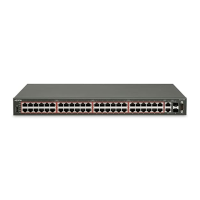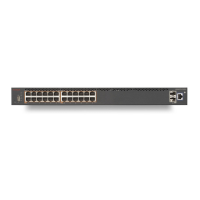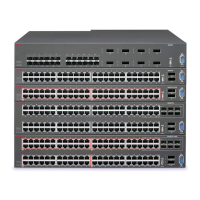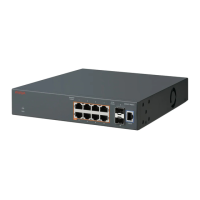Avaya Inc. – External Distribution
qos traffic-profile classifier name fivePrecs dst-ip 1.2.3.5/32 drop-action enable
eval-order 2
qos traffic-profile classifier name fivePrecs dst-ip 1.2.3.6/32 drop-action enable
eval-order 3
qos traffic-profile classifier name fivePrecs ds-field 23 drop-action enable block
dscpBlk eval-order 10
qos traffic-profile classifier name fivePrecs ds-field 24 drop-action enable block
dscpBlk eval-order 11
qos traffic-profile classifier name fivePrecs protocol 111 drop-action enable block
protoBlk eval-order 20
qos traffic-profile classifier name fivePrecs protocol 112 drop-action enable block
protoBlk eval-order 21
qos traffic-profile set port 1-2 name fivePrecs track-statistics aggregate
4526GTX-60pwr(config)#show qos diag
Unit/Port Mask Precedence Usage
8 7 6 5 4 3 2 1
--------- -------------------------------
1/1 AR Q Q Q Q Q Q Q
1/2 AR Q Q Q Q Q Q Q
Please note that with the ERS 4800 using release 5.8 or higher increases the number of QoS filter
precedences from 8 to 16. Starting at release 5.8, support for the ERS4500 series is no longer supported.
If QoS or non-QoS applications are consuming resources on the target port, a different starting
precedence will be selected if one is available. In the following example, precedence 10 is consumed by
the IPSG application and 5 consecutive precedence levels are only available starting at precedence 9:
5650TD(config)#show qos diag
Unit/Port Mask Precedence Usage
16 15 14 13 12 11 10 9 8 7 6 5 4 3 2 1
--------- ---------------------------------------------------------------
1/1 AR DH IS Q Q Q Q Q Q Q
1/2 AR DH Q Q
AR=ARP DH=DHCP Q=QoS IS=IPSG
Aside from precedence masks, filter set installation consumes filter (one per classifier element) and
potentially meter and counter resources. The availability of these resources, tracked on a per-port
(ERS55XX) or per-port cluster (ERS4XXX/ERS56XX/59XX/ERS59XX) basis, may limit whether a filter set
can be applied to a port. It is also important to remember that adding classifier elements to an in-use filter
set impacts resource requirements by changing the precedence mask requirements and/or the filter,
meter, etc. resource requirements.
Filter Set Port Assignment: filter sets are associated with a port in different ways. Non-QoS
applications, such as NSNA and UBP, use filter sets as a template. The filter set, when defined, is not
associated with port but an instance of the filter set is created and installed based on application
operation. Traffic-profile filter sets are associated with a port when defined by the user. A valid, QoS-
enabled port must be provided by the administrator for the filter set installation to succeed.
Filter Set Metering: the ability to meter traffic processed by a filter set is currently limited. Metering data
may be defined for the filter set overall but not for the individual classifiers. When metering data is
specified, a meter is associated with each classifier and unique classifier block. Each meter has the same
characteristics (e.g., committed rate, burst size) and is independently evaluated (i.e., there is no
relationship between meters associated with different filter set classifiers/blocks). Conforming (i.e., in-
profile) traffic is processed based on the action criteria associated with the individual classifier or block

